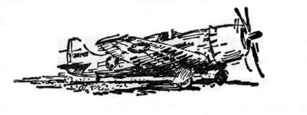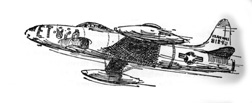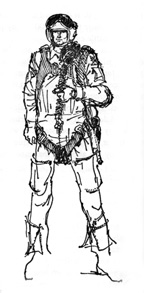Biographical Notes, Cont.Relating to Ancil D. Baker
|
|||||||||||||||
| “When lend-lease aircraft began to arrive for delivery to Russian pilots, cold weather problems began at Great Falls, Montana and progressed all the way up through western Canada. Tenant Russian and American Ferry Command personnel soon outnumbered those in the Cold Weather Test Detachment. |
|||||||||||||||
“Three years I spent there pioneering cold weather testing of airplanes and equipment. With smaller liaison airplanes on skis and floats, as well as wheels I was able to experience the bush pilot trade of visiting remote mining, fishing and trapping camps throughout the Territory of Alaska. |
|||||||||||||||
 |
|||||||||||||||
| “The runway was outlined with Christmas trees and for night landings smudge pots were lighted and place between the trees. “Some days engines couldn't be started before the short hours of daylight ended. |
|||||||||||||||
| “The day I departed Ladd Field, I visited the proposed site of Eielson Field, a mile row of surveyor stakes spaced a hundred feet apart in the middle of a six foot lane cut through brush to mark the center line of the proposed runway. |
 |
||||||||||||||
| “Then a year at Wright Field where I found myself among many more different types of aircraft. I flew the first US jet plane, the Bell XP-59 and the first helicopter, the Sikorsky XR-4B and dropped the first Sno Cat by parachutes from a Douglas C-54. “Wright Field was also responsible for all the air corps depots, not the least of which was at Townsville, Australia, to which I was next assigned. Genevieve went back to Spokane. “Aircraft and equipment of all types arrived in townsville by boat and were reassembled and tested before being sent to New Guinea. Some days I flight tested as many as four different types. “On 21February 1945 I landed the first airplane on Nichols Field, Manila, and on 9 July the first helicopter, an R-4B to be seen in the Philippine Islands. Later that summer I was present when the Japanese peace negotiators landed. |
|||||||||||||||
| “On 19 September1945 I flew the first helicopter in Japan and viewed the Japanese battleship Nagato in Tokyo Bay. “On 22 march 1946 I landed the first helicopter, an R-4D, on the island of Guam. |
|||||||||||||||
 |
|||||||||||||||
| “On 10 may 1946 I landed the first helicopter, a Bell R-6A on Kwajalien Island where I became a charter member of the Grand Council, Exclusive Order of Guinea Pigs, Sty NO. 1, and participated in the Bikini Atoll atomic bomb testing. “Back in the Tokyo Bay area I assembled and tested new P-51 airplanes arriving by boat at the port of Yokohama. |
|||||||||||||||
| “I finally got home from the war in February 1947 and became commander of the new Climactic Test Hangar at Eglin Field, Florida where the inaugural cold temperature tests were run on several airplanes and ancillary ground equipment that summer. Included were the new B-36 with six pusher propellers and four axial flow jet engines as well as the new P-80 jet pursuit plane. |
|||||||||||||||
 |
|||||||||||||||
| “Genevieve and I witnessed the filming of "Twelve O'clock High" and made friends with several of the cast. Gregory Peck played the part of General Frank Armstrong who was my flight leader back at Barksdale Field, my first assignment out of Flying School. “After testing and flying over seventy-five different types of airplanes, not to mention many different models of the same type, I left that kind of work for an assignment to the Air Force Senior Staff Officers School at the University of Pittsburgh. In those days, when I was at home studying, Genevieve took in the luncheon style shows at Kauffman's and Horns's. “Next, to Strategic Air Command's 15th Air Force Headquarters, Riverside, California. While there I was privileged to witness an atomic bomb test over in Nevada. “From there I went with the 9th B-29 Bombardment Wing to Mountain Home, Idaho and then back again to Yokota, Japan during the Korean War. |
|||||||||||||||
 |
|||||||||||||||
| “In 1954 I was transferred with the entire 98th Bombardment Wing to Lincoln, Nebraska, where we all transitioned into Boeing B-47 aircraft. I was immediately appointed an Admiral in the Great Navy of the State of Nebraska, by Governor Robert B. Crosby. Later, the Wing served a temporary duty assignment in Lakenheath, England. |
|||||||||||||||
| “Next to last was the transfer to Bolling AFB, Washington, DC where Genevieve found a reliable baby-sitter, resumed her hobby of painting and entered numerous art shows. “Hamilton AFB was my final assignment and Genevieve joined the Marin Art Association. Her showplace home is like an art gallery with her oil and watercolor paintings covering its walls. “I retired at Hamilton AFB in June 1966, bought a home in San Rafael and lived in it until 1 November 1997 when we moved to our Northern California Retired Officers Community, Paradise Valley Estates, Fairfield, California, and Genevieve, at long last, got to retire. |
|||||||||||||||
 |
|||||||||||||||
|
Gil Walker |
|||||||||||||||
| “In 1972 we bought a 32-foot Airstream Trailer, joined the Northern California Wally Byam Trailer Club and toured Western US and Canada for the better part of ten years. It was interesting to me to visit, close-up, many of the wonders that I had viewed from on high. “Our new home is very much like Air Force Village, San Antonio and Air Force Village, West, Riverside, California. “Our sixty-third anniversary was 27 November 2000. “I expect to live here another sixteen years, when I will be one hundred an five years old. |
|||||||||||||||
|
Go to Intro. Page or Pages 1 — 2 — 3 or Or you may go to Home - Contact Us - Cold War Hist. - 91st SRS Hist. - Stardust 40 Mission Story |
|||||||||||||||